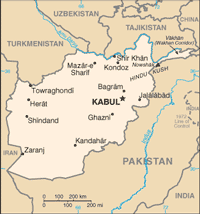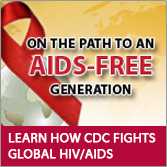Afghanistan
HIV/AIDS in Afghanistan
- NA Estimated Prevalence
(Age 15–49) - NA Estimated Deaths (2007)
- NA Estimated Orphans
- NA Reported Number of People Receiving ART
- NA Estimated Number of People Needing ART
SOURCE:
2008 Report on the global AIDS epidemic, UNAIDS/WHO, July 2008
Towards Universal Access: Scaling up priority HIV/AIDS interventions in the health sector, WHO 2008

HIV/AIDS Assets and Strategic Focus
Strategic Focus
CDC began supporting Afghanistan in 2008 for HIV/AIDS capacity building, which included conducting a needs assessment, building laboratory capacity, and improving the safety of blood collection, processing, and transfusion practices.
Since then, CDC has provided technical leadership and direct assistance to the Afghanistan government to strengthen epidemiology, surveillance, laboratory safety and adequacy of the national blood supply, operations research, and workforce capacity—essential components for a sustainable public health system.
Program Goals
CDC efforts have focused on three primary goals
Biomedical Prevention–Increasing the availability of a safe national blood supply via the Afghanistan National Blood Safety and Transfusion Service (ANBSTS).
Strengthen the Central Public Health Laboratory to serve as the National HIV Reference Laboratory.
Strengthen the HIV surveillance component of strategic information systems to guide policy formation and program development.
Notable Accomplishments
Laboratory
Worked with the National AIDS Control Program and the Ministry of Public Health (MoPH) to establish a national HIV testing algorithm that has been implemented at all HIV testing sites in Afghanistan.
Provided two point-of-care CD4 instruments to the HIV antiretroviral therapy treatment clinics in Kabul and Herat, trained 10 clinicians and laboratory staff, and set up a quality monitoring system.
Trained staff from 11 voluntary counseling and testing clinics in Afghanistan to conduct quality assurance monitoring of rapid HIV tests.
Blood Safety
Provided ongoing technical assistance and training to the director of the ANBSTS on blood safety and thalassemia management.
In collaboration with WHO partners, coordinated the acquisition of transportation to allow for mobile blood collections.
Put in place a mechanism to provide technical assistance in updating the MoPH’s 2009 goals for blood safety and to provide training in blood transfusion practices and safety for 40 physicians, 40 nurse/midwives and 40 hospital laboratorians.
Contact Us:
- Centers for Disease Control and Prevention
1600 Clifton Rd
Atlanta, GA 30333 - 800-CDC-INFO
(800-232-4636)
TTY: (888) 232-6348
24 Hours/Every Day - cdcinfo@cdc.gov
 ShareCompartir
ShareCompartir



